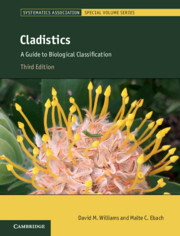Book contents
- Cladistics
- The Systematics Association Special Volume Series
- Cladistics
- Copyright page
- Dedication
- Contents
- Preface
- Acknowledgements
- Introduction: Carving Nature at Its Joints, or Why Birds Are Not Dinosaurs and Men Are Not Apes
- Part I The Interrelationships of Organisms
- Part II Systematics: Exposing Myths
- 3 Relationship Diagrams
- 4 Essentialism and Typology
- 5 Monothetic and Polythetic Taxa
- 6 Non-taxa or the Absence of –Phyly: Paraphyly and Aphyly
- Part III The Cladistic Programme
- Part IV How to Study Classification
- Part V Beyond Classification
- Afterword
- Index
- Systematics Association Special Volumes
- References
6 - Non-taxa or the Absence of –Phyly: Paraphyly and Aphyly
from Part II - Systematics: Exposing Myths
Published online by Cambridge University Press: 20 July 2020
- Cladistics
- The Systematics Association Special Volume Series
- Cladistics
- Copyright page
- Dedication
- Contents
- Preface
- Acknowledgements
- Introduction: Carving Nature at Its Joints, or Why Birds Are Not Dinosaurs and Men Are Not Apes
- Part I The Interrelationships of Organisms
- Part II Systematics: Exposing Myths
- 3 Relationship Diagrams
- 4 Essentialism and Typology
- 5 Monothetic and Polythetic Taxa
- 6 Non-taxa or the Absence of –Phyly: Paraphyly and Aphyly
- Part III The Cladistic Programme
- Part IV How to Study Classification
- Part V Beyond Classification
- Afterword
- Index
- Systematics Association Special Volumes
- References
Summary
We will treat the terms monophyly and monophyletic group in more detail in Chapter 7. Briefly, it refers to a taxon characterised by at least one synapomorphy (also further discussed in Chapter 7). Many recent definitions of monophyly have been based on ancestry. This book is focused on classification, so here monophyly is considered to be an empirical concept, matching evidence to conclusions. Monophyletic groups are taxa; but not all taxa are monophyletic – they are, for the most part, assumed to be so.
- Type
- Chapter
- Information
- CladisticsA Guide to Biological Classification, pp. 124 - 148Publisher: Cambridge University PressPrint publication year: 2020



